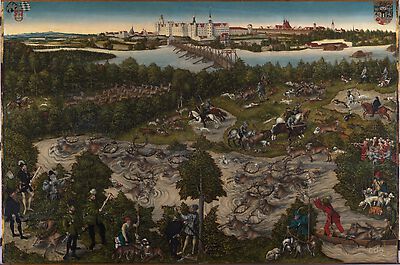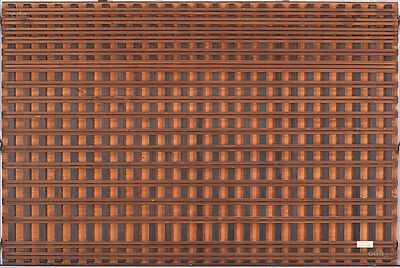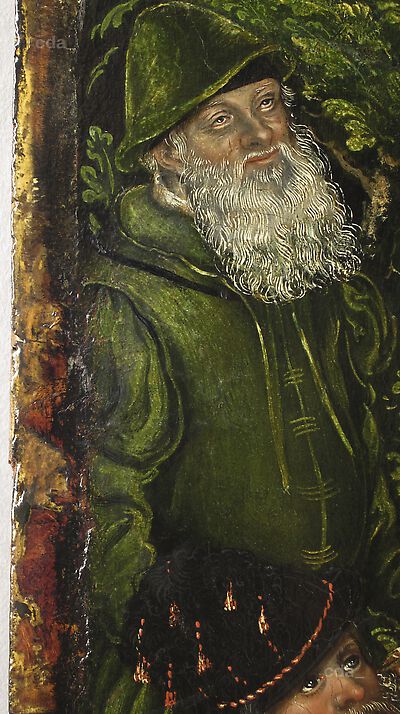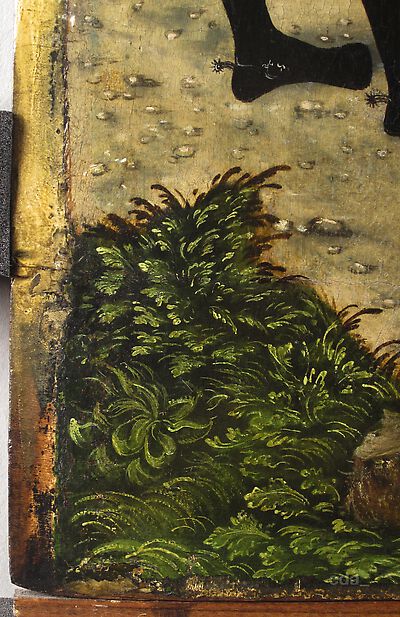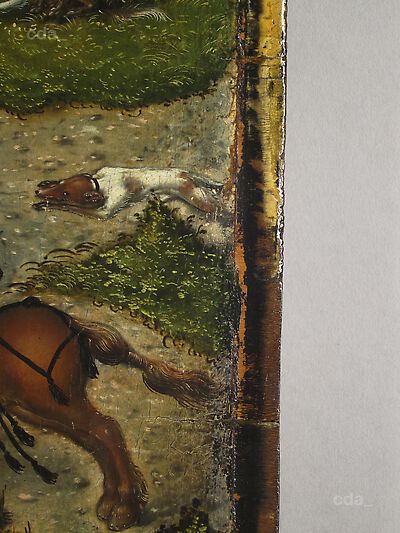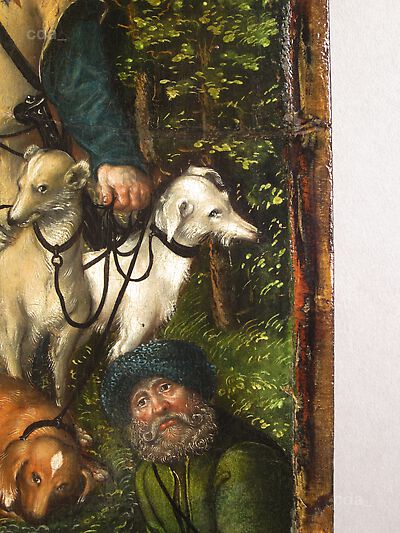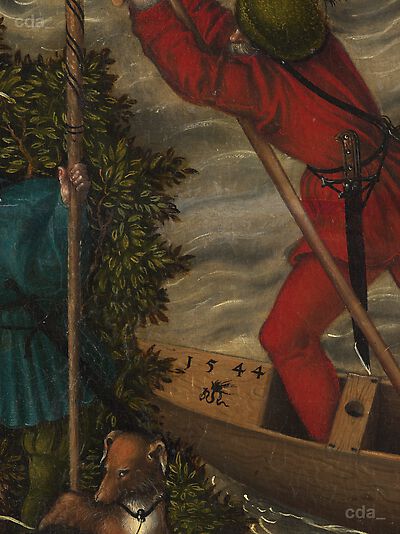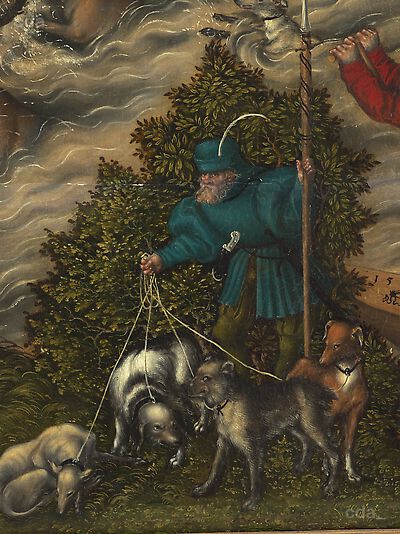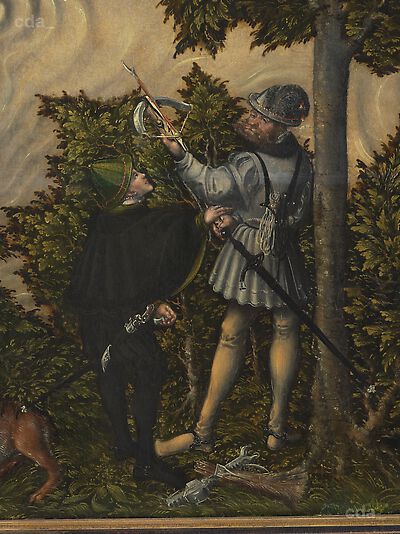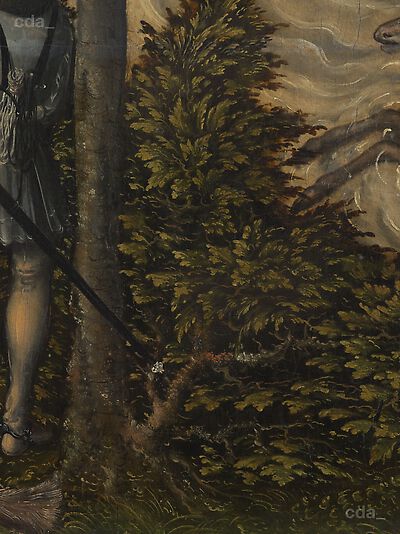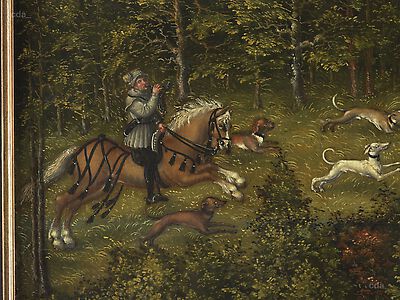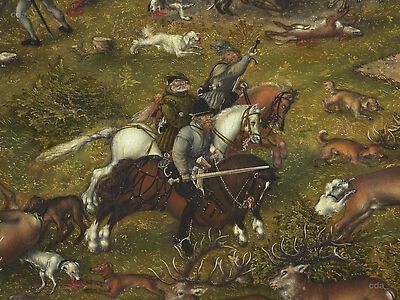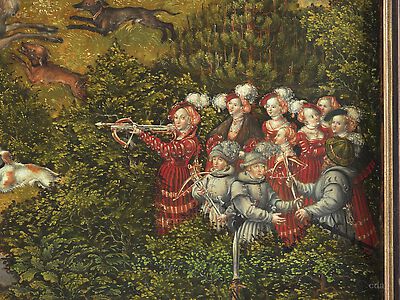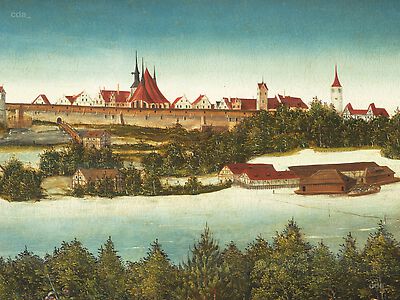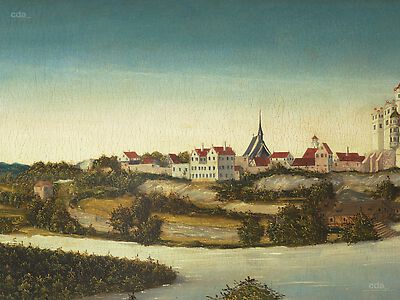- Attributions
-
Lucas Cranach the Younger
Lucas Cranach the Elder
Attributions
| Lucas Cranach the Younger | [Friedländer, Rosenberg 1979, No. 412C] Lucas Cranach the Elder with the assistance of Cranach the Younger |
| Lucas Cranach the Elder | Lucas Cranach the Elder 'Original von Lucas Crainich' Lucas Cranach the Elder with the assistance of Cranach the Younger |
- Production date
- 1544
Production date
| 1544 | [dated] |
- Dimensions
- Dimensions of support: 116.2/ 116.3 (l.) 116.0 (r.) x 176.4 (t./b.) cm
Dimensions
Dimensions of support: 116.2/ 116.3 (l.) 116.0 (r.) x 176.4 (t./b.) cm
Dimensions of painted surface: 116.2/ 116.3 (l.) 116.0 (r.) x 173.8 (t.) 174.5 (b.) cm
Dimensions including frame: 116 x 176.5 x 7.7 cm
[Kunsthistorisches Museum, revised 2013]
- Signature / Dating
Artist's insignia in the bottom right corner (on the boat): winged serpent with dropped wings and ring facing left and dated '1544'; in black paint
Signature / Dating
Artist's insignia in the bottom right corner (on the boat): winged serpent with dropped wings and ring facing left and dated '1544'; in black paint
[Kunsthistorisches Museum, revised 2013]
- Inscriptions and Labels
Coat of arms, top left: Electoral Palatinate
Coat of arms, top right: Electoral Saxony
[see Johann …Inscriptions and Labels
Inscriptions, Badges:
Coat of arms, top left: Electoral Palatinate
Coat of arms, top right: Electoral Saxony
Stamps, Seals, Labels:
Reverse of the panel/cradle:
- on the horizontal cradle batten, top right:
in pencil: '11. IV. 552'
- on the horizontal cradle batten, bottom right:
printed paper label: 'Direktion der Gemäldegalerie, Kunsthistorisches Staatsmuseum, Inv. Nr. 856'
[Kunsthistorisches Museum, revised 2013]
- Owner
- Kunsthistorisches Museum, Vienna
- Repository
- Kunsthistorisches Museum, Vienna
- Location
- Vienna
- CDA ID
- AT_KHM_GG856
- FR (1978) Nr.
- FR412C
- Persistent Link
- https://lucascranach.org/en/AT_KHM_GG856/
Provenance
- first recorded in the Imperial Collection in Vienna in the inventory of Archduke Leopold Wilhelm 1659
[Source: No. 350 'Ein grosses Stuckh von Öhlfarb auf Holcz, warin ein Wasserjacht von Hierschen bey Neüburg ahn der Donnaw, warbey Caroli Vti vnd anderer Chur- vndt Fürsten vnd deren Gemahlin Contrafait seindt. In einer schwartzen Ramen, hoch 6 Span 2 Finger vnndt 8 Span 9 Finger braidt. Original von Lucas Crainich (A large piece in oil paint and wood, on which a water hunt of stags near Neuburg on the Danube [is depicted], whereby Charles V. and other electors and their wives are portrayed. In a black frame, 6 span and 2 fingers high and 8 span and 9 fingers wide. Original by Lucas Crainich)', in: 'Inventarium aller vnndt jeder Ihrer hochfürstlichen Durchleücht Herrn Herrn Leopoldt Wilhelmen [...] zue Wienn vorhandenen Mahllereyen [...]', written on 14.6.1659 by Anton van der Baren, formerly Krumau, Fürstl. Schwarzenbergsches central archive., publish by: [Berger, Adolf (1883): Regest 495, in: Jahrbuch der kunsthistorischen Sammlungen des Allerhöchsten Kaiserhauses, Jg. 1, S. LXXXVI¿CLXXVII]
1772 Stallburg Vienna, Store room
[Source: Gallery Floor No. 76: 'Grosses Jagd-Stück, eine Copey (large Hunting Scene, a copy)', in: 'Inventarium über Die in der Kaiserl. königl. bilder-Gallerie vorhandene Bilder und gemälde 1772', KHM, archive in the Gemäldegalerie]
1801 Schloß Laxenburg, decorative furnishing
[Source: 'Nota. Aus dem k.k. Bilder Depositorium übersendte Bilder in das Ritter Schloß nach Laxenbourg. [...] 1 Stück Eine Landschaft mit Figuren alt teutscher Tracht. [...] Wien d. 21 April 1801.', GG Archive, Gallery file, Mappe 1805-1820, sub IV/ 199; [Cat. Vienna 1886, Bd. III, 53]
Imperial palace am Rennweg, Vienna
[Cat. Vienna 1886, Bd. III, 53]
1837 Belvedere, Imperial Picture Gallery
[Cat. Vienna 1837, 199, No. 36]
1892 Kunsthistorisches Hofmuseum, Burgring 5, Picture Gallery
[Cat. Vienna 1892, 385-386, No. 1532]
[Kunsthistorisches Museum, revised 2013]
Exhibitions
Graz 1949
Graz 1953
Vienna 1972
Vienna 2000
Literature
| Reference on page | Catalogue Number | Figure / Plate | |||||||||||||||||
| Exhib. Cat. Gotha, Kassel 2015 | 236 | ||||||||||||||||||
|
|||||||||||||||||||
| Hoppe-Harnoncourt 2015 | 155-157, 160, 162, 163, 165 | Figs. 1, 2, 5 | |||||||||||||||||
|
|||||||||||||||||||
| Müller 2009 B | 107-108 | ||||||||||||||||||
|
|||||||||||||||||||
| Pérez d'Ors 2005 | 8, 16 | ||||||||||||||||||
|
|||||||||||||||||||
| Exhib. Cat. Torgau 2004 | 159 | ||||||||||||||||||
|
|||||||||||||||||||
| Hancke 2004 | 49, 53-54 | Fig. 8; Detail Fig. 10 | |||||||||||||||||
|
|||||||||||||||||||
| Müller 2004 | 348-349 | ||||||||||||||||||
|
|||||||||||||||||||
| Schulze 2004 | 78-82, 86-87 | Fig. p. 86 | |||||||||||||||||
|
|||||||||||||||||||
| Exhib. Cat. Bonn, Vienna 2000 | 330-331 | No. 372 | |||||||||||||||||
|
|||||||||||||||||||
| Roch-Lemmer 2000 | 222 | ||||||||||||||||||
|
|||||||||||||||||||
| Malacarne 1998 | 50 | colour fig. | |||||||||||||||||
|
|||||||||||||||||||
| Hagen 1995 | 54-59 | colour fig.; detail | |||||||||||||||||
|
|||||||||||||||||||
| Exhib. Cat. Kronach 1994 | 311, 371 | ||||||||||||||||||
|
|||||||||||||||||||
| Grimm 1994 | 33 | ||||||||||||||||||
|
|||||||||||||||||||
| Stievermann 1994 | 67 | Fig. A34 (detail) | |||||||||||||||||
|
|||||||||||||||||||
| Cat. Vienna 1991 | 47 | Plate 598 | |||||||||||||||||
|
|||||||||||||||||||
| Cat. Cleveland 1982 | 163-165 | Fig. 66b | |||||||||||||||||
|
|||||||||||||||||||
| Friedländer, Rosenberg 1979 | 412C | ||||||||||||||||||
|
|||||||||||||||||||
| Exhib. Cat. Basel 1974/1976 | 203, 771, Fn. 22 | Fig. 106 | |||||||||||||||||
|
|||||||||||||||||||
| Koepplin 1974 C | 196 | ||||||||||||||||||
|
|||||||||||||||||||
| Schade 1974 | 94 | ||||||||||||||||||
|
|||||||||||||||||||
| Cat. Vienna 1973 | 51 | Pl. 131 | |||||||||||||||||
|
|||||||||||||||||||
| Exhib. Cat. Vienna 1972 | 31-32 | No. 25 | |||||||||||||||||
|
|||||||||||||||||||
| Hilger 1969 | 129 | ||||||||||||||||||
|
|||||||||||||||||||
| Osten, Vey 1969 | 208 | ||||||||||||||||||
|
|||||||||||||||||||
| Cat. Vienna 1963 | 39-40 | No. 117 | |||||||||||||||||
|
|||||||||||||||||||
| Sternelle 1963 | 20, 30 | Plate 9 | |||||||||||||||||
|
|||||||||||||||||||
| Francis 1959 | 204, Fn. 14 | ||||||||||||||||||
|
|||||||||||||||||||
| Oberhammer 1959 | No. 22 | Plate 22 | |||||||||||||||||
|
|||||||||||||||||||
| Cat. Vienna 1958 | 38-39 | No. 117 | |||||||||||||||||
|
|||||||||||||||||||
| Exhib. Cat. Graz 1953 | 27-28 | No. 41 | Fig. 14 | ||||||||||||||||
|
|||||||||||||||||||
| Exhib. Cat. Graz 1949 | 11 | No. 5 | |||||||||||||||||
|
|||||||||||||||||||
| Lilienfein 1942 | 86 | Fig. 121 | |||||||||||||||||
|
|||||||||||||||||||
| Zimmermann E. H. 1942 B | 36 | ||||||||||||||||||
|
|||||||||||||||||||
| Zimmermann E. H. 1941 | 31 | ||||||||||||||||||
|
|||||||||||||||||||
| Cat. Vienna 1938 | 43 | No. 1468 | |||||||||||||||||
|
|||||||||||||||||||
| Friedländer, Rosenberg 1932 | 91 | 331b | |||||||||||||||||
|
|||||||||||||||||||
| Baldass 1928 | 76, Fn. 2 | ||||||||||||||||||
|
|||||||||||||||||||
| Cat. Vienna 1928 | 58-59 | No. 1468 | |||||||||||||||||
|
|||||||||||||||||||
| Cat. Vienna 1907 | 339 | No. 1468 | |||||||||||||||||
|
|||||||||||||||||||
| Baillie-Grohman 1904 | 158 | ||||||||||||||||||
|
|||||||||||||||||||
| Cat. Vienna 1896 B | 427 | No. 1468 | |||||||||||||||||
|
|||||||||||||||||||
| Cat. Vienna 1892 | 385-386 | No. 1532 | |||||||||||||||||
|
|||||||||||||||||||
| Scheibler 1887 | 297-298, 299 | ||||||||||||||||||
|
|||||||||||||||||||
| Cat. Vienna 1886 | 52-53 (Bd. III) | No. 1481 | |||||||||||||||||
|
|||||||||||||||||||
| Waagen 1866 | 164 | No. 36 | |||||||||||||||||
|
|||||||||||||||||||
| Cat. Vienna 1858 | 116 | No. 36 | |||||||||||||||||
|
|||||||||||||||||||
| Schuchardt 1851 C | 138 | 430 | |||||||||||||||||
|
|||||||||||||||||||
| Cat. Vienna 1837 | 199 | No. 36 | |||||||||||||||||
|
|||||||||||||||||||
Research History / Discussion
The painting first entered the Imperial Gallery’s public collection in 1837 and was classified as a work by Lucas Cranach the Elder. [1] Schuchardt attributed the stag hunt to the younger Cranach on the basis of stylistic criteria.[2] Whereas Engerth conjectured that the son assisted only with the ‚accessories‘ Scheibler agreed with Schuchardt’s attribution.[3] In the Museum guide from 1896 Scheibler’s opinion is accepted, however it was retracted in the reprint from 1907. At length since 1928 the Stag-hunt has been attributed to Lucas Cranach the Younger in the catalogues of the Kunsthistorischen Museum.[4] Friedländer and Rosenberg view the painting in Vienna, as well as the Stag-hunt, dated 1540 and now in Cleveland, as variants after the painting in Madrid from 1545 and are inclined to consider it ‚preferably‘ as a work by Lucas Cranach the Younger, whereas they attribute the later paintings in Madrid to the Elder.[5]
The electoral pair from Saxony, Johann Friedrich and Sibylle, as well as their most prominent guest Emperor Charles V are clearly recognizable.[6] In the background the castle Hartenfels and the town of Torgau can be easily identified.[7] From 1928 it was assumed that not Charles V. but his brother King Ferdinand (later Emperor Ferdinand I.) was among the hunting guests.[8] In 1969 Hilger pointed out that King Ferdinand did not grow a beard until after 1547 and that therefore it could only be Charles V. portrayed in this hunting scene.[9] Friedrich II of the Pfalz can be seen directly in front of the emperor.[10] The Golden Fleece as well as the coat-of-arms of the Electoral Palatinate in the top left corner support this assumption.[11]
There are various suggestions regarding the identity of the crossbow archer in greyish blue clothing standing beneath the tree: Oberhammer assumes it is Duke Ernst of Braunschweig-Lüneburg (1497-1546).[12] The other suggestion is that Duke Philipp I of Braunschweig-Grubenhagen (1476-1551) could be the archer under the tree.[13]
The hunt was already the subject of artistic expression at the court of Emperor Maximilian I. by about 1500 (see Jörg Kölderer, ‚Stag-hunt on the Long Lawn near Innsbruck, Illustration in Emperor Maximilians I.’s ‘Tirol Hunting Book, 1500). Therefore from the beginning of his career as court painter in Wittenberg Cranach also dealt with this subject. His earliest Hunting Scene is a large woodcut, dated to 1506 (Bartsch 119): The composition of a hunt in the countryside, shown from a high viewpoint, can already be found quite early in Cranach’s repertoire. It may be assumed that numerous such depictions were executed on ‚tuchlein‘ or as wall-paintings for decorative purposes and have not been preserved.[14] There are however some panel paintings and fragments of hunting scenes which have survived from the Cranach workshop: The earlier ones can be dated about 1530 (e.g. Kunsthistorisches Museum, GG-3560; Kopenhagen, Statens Museum for Kunst, Inv. KMSsp728; Linköping, Länsmuseet Östergötland, Inv. B. 244; Glasgow, Burell Coll.). The later versions are from the 1540s and are with dimensions of c. 115 x 170 cm larger formats: among these are, in addition to the painting discussed, one from the castle of Moritzburg from 1540 (now in Cleveland), a panel in the Prado from 1544 and another painting also there from the year 1545 (see related works).
The paintings created in the 1540s are not only similar in size and composition, all four also depict the castle of Hartenfels and the electoral pair Johann Friedrich and Sybille of Saxony among the participants at the hunt.
The hunting scenes in Cleveland (1540) and the Prado (1544) show, although not quite accurate in detail, the south east elevation of the castle complex.[15]
A different elevation is shown in the painting discussed here from 1544 and the second painting from 1545 in Madrid: here the Northeast facade facing the Elbe is shown and to the left the whole Johann-Friedrich wing (as such the prominent ‚green tower‘ occupies a central position). A further feature of this wing is the ‚bottle tower‘ with its winding stair. The castle chapel, rising over three floors, is located in the right section of the wing, and as the first new protestant church building was consecrated by Martin Luther on the 5th of October 1544.[16]
It has already been established that an historical hunting scene has not been documented, as Charles V. was never in Torgau before the Battle of Mühlberg.[17] The hunting scenes from the 1540s were conceived as gifts for other ruling houses and should convey a symbolic statement: the commissioner of the painting, Johann Friedrich of Sachsen, was the commander of the Schmalkaldic League, the military alliance of protestant landlords in opposition to the emperor. In the painting the opposing parties are shown hunting together. The recently modernized castle of Hartenfels, positioned centrally in the background, is shown as a representative residence but also as the centre of the new faith. In the years before the Schmalkaldic war there was still hope, that the question of faith could be peacefully resolved with Charles V. It was not until after the Battle of Mühlberg that this option no longer existed under Charles V. The hunting scenes in Madrid and Vienna therefore convey the elector’s political ideal.[18] Represented as a hunter in front of his imposing residence the elector presents himself to the contemporary viewer as a wise, able and determined territorial prince, capable of asserting his religious political goals.[19]
[1] A. Krafft, Verzeichnis der Gemäldegalerie, Vienna 1837, p. 199, Cat. 36
[2] C. Schuchardt Lucas Cranach d. Ä. Leben und Werke, Leipzig 1851, Bd. 2, p. 138
[3] E. Engerth, Beschreibendes Verzeichnis, Kunsthist. Slg. d. a.h. Kaiserhauses. Bd. III Deutsche Schulen, Wien 1886, p. 52, No. 1481; L. Scheibler: Über altdeutsche Gemälde in der kaiserlichen Galerie zu Wien, in: Rep. f. Kw., 10, 1887, p. 297-299
[4] Cat. KHM 1896, 1907 and 1928, each with the No. 1468.
[5] Friedländer, Rosenberg 1979, under No. 412
[6] First by A. Krafft, Verzeichnis der Gemäldegalerie, Vienna 1837, Cat. 36
[7] First attributed by W. A. Baillie-Grohman, Ancient Weapons of the Chase, in: Burl. Magazine, IV, 11, 1904, p. 158
[8] Cat. KHM 1928, No. 1468
[9] Hilger, Wolfgang (1969): Ikonographie Kaiser Ferdinands I : (1503 - 1564). Wien: Böhlau (Veröffentlichungen der Kommission für Geschichte Österreichs, 3), p. 129; Hilger, Wolfgang (2003): "Das Bild vom König und Kaiser". Anmerkungen zu Verbreitung und Wirkungsgeschichte von Herrscherdarstellungen am Beispiel Ferdinands I. In: Seipel, Wilfried (ed.): Kaiser Ferdinand I. 1503 - 1564 ; das Werden der Habsburgermonarchie. Vienna, p. 231–241, p. 137-138
[10] Oberhammer, Vinzenz (ed.) (1959): Die Gemäldegalerie des Kunsthistorischen Museums. 1. Halbband: Malerei nördlich der Alpen XV. - XVII. Jahrhundert. 100 plates. Vienna, Munich, Text for plate 22
[11] The same coat-of-arms can be found in the glass salon (Gläsernen Saalbau) in the castle of Heidelberg (vgl. Wappen der Kurlinie Pfalz: http://www.dr-bernhard-peter.de/Heraldik/wittelsbach.htm), which was built by Friedrich II. (see http://de.wikipedia.org/wiki/Heidelberger_Schloss). In 1544 Friedrich succeeded his brother in office as elector and arch-steward. He is also depicted in the painting in Madrid at the left behind the emperor. Compare also the portrait by an anonymous German artist: Count Palatine Friedrich II. (1482-1556), as a full-length figure, 1545, KHM, GG-8177.
[12] Oberhammer (1959), op. cit., Text for plate 22. He presumably orientated himself on Friedländer and Rosenberg’s identification of the man in the same position in the Madrid painting from 1545 [see Friedländer, Rosenberg 1932, No. 331 and 1979, No. 412] although this person in the Madrid painting can be correctly identified as Ernst of Braunschweig-Grubenhagen, as was suggested by Rosenberg 1934 and Zimmermann 1942 [E.H. Zimmermann, „Ein Bildnisentwurf Lucas Cranachs d. J.“, in: Berliner Museen, Bd. 63, Heft 1, 1942, p. 2-4, p. 4; J. Rosenberg, „Deutsche Bildniszeichnungen des XVI. Jahrhunderts im Museum zu Reims“, in: Jahrbuch der Preußischen Kunstsammlungen, Bd. 55, 1934, p. 181-191, p. 185]
[13] Zimmermann, E. Heinrich (1942): Beiträge zur Ikonographie Cranachscher Bildnisse. In: Zeitschrift des Deutschen Vereins für Kunstwissenschaft, Jg. 9, p. 23–52, p. 36
[14] Last: G. Messling in: AK Brüssel 2010, p. 129-130; B. Aikema in: AK Rom 2010, Kat. 1 und 2; Sternelle; AK Veste Coburg 2010, Apelles am Fürstenhof, bes. p. 208-223.
[15] The Johann-Friedrich wing can be seen, as it was designed and built by Konrad Krebs between 1533-36. On the right side the prominent ‘green tower’ with its onion-dome is recognizable. [S. Delang, Schloß Hartenfels Torgau, (Schnell, Kunstführer No. 2295), 1. edition 1997, p. 8-14; Findeisen, Peter; Magirius, Heinrich (ed.): Die Denkmale der Stadt Torgau. Leipzig 1976 (Die Denkmale im Bezirk Leipzig), p. 138-140, p. 147]
[16] see Dehio, Bezirke Dresden, Karl-Marx-Stadt, Leipzig, Berlin 1965, p. 403-405; Findeisen, Peter; Magirius, Heinrich (ed.): Die Denkmale der Stadt Torgau. Leipzig 1976 (Die Denkmale im Bezirk Leipzig), p. 172; Hancke, Hansjochen: Das Torgauer Stadtbild und die Ansichten von Lucas Cranach. In: Stockhausen, Tilmann von; Hollberg, Cecilie (ed.): Torgau - Stadt der Renaissance. Erschienen aus Anlass der 2. Sächsischen Landesausstellung in Torgau, [Schloß Hartenfels 24. May to 10 October 2004]. 2., revised Dresden 2004, p. 49–57, S. 53; Pérez d'Ors, Pablo: Dos Cacerás de Lucas Cranach el Viejo en el Museo del Prado. Nuevos datos sobre las dos escenas de caza: historia material, obras similares y claves para su interpretación iconográfica e iconológica. In: Boletín del Museo del Prado, vol. 23, 2008, p. 6–22, p. 8-10, 16.
[17] Among others: Schütz, Karl (1972): Lucas Cranach der Ältere und seine Werkstatt. Jubiläumsausstellung museumseigener Werke 1472 - 1972. Vienna 1972, Cat. 25.
[18] Pérez d'Ors, Pablo: Dos Cacerás de Lucas Cranach el Viejo en el Museo del Prado. Nuevos datos sobre las dos escenas de caza: historia material, obras similares y claves para su interpretación iconográfica e iconológica. In: Boletín del Museo del Prado, Vol. 23, 2005, p. 6–22, bes. p. 17-18; Schulze, Ingrid: Lucas Cranach d. J. und die protestantische Bildkunst in Sachsen und Thüringen. Frömmigkeit, Theologie, Fürstenreformation. 1. edition. Bucha bei Jena 2004 (Palmbaum-Texte, 13), p. 78-80.
[19] Matthias Müller makes reference to the regent ethics formulated in the contemporary ‚Mirrors for Princes‘ within the context oft he hunt. Müller, Matthias (2004): Das Schloß als Bild des Fürsten. Herrschaftliche Metaphorik in der Residenzarchitektur des Alten Reichs. Göttingen (Historische Semantik, 6), p. 348-349.
[Hoppe-Harnoncourt, Kunsthistorisches Museum, revised 2013]
